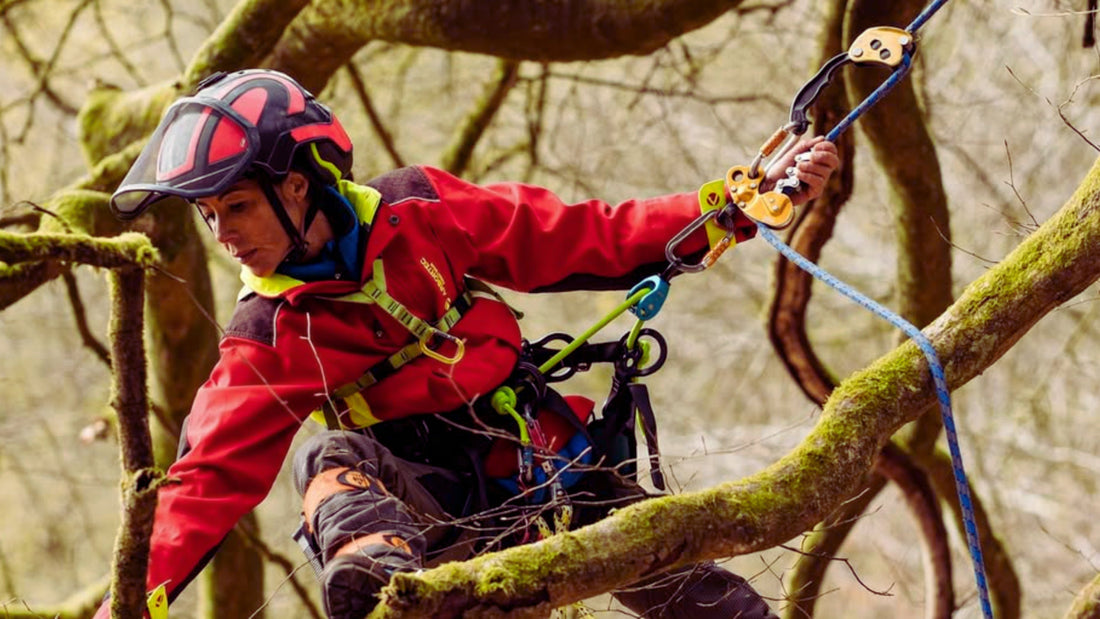Bianca die Arboristin
Wenn du mir vor zehn Jahren gesagt hättest, dass ich meinen Lebensunterhalt damit verdienen würde, riesige Bäume zu erklimmen, mit einem Kopf voller Staunen, hätte ich dich wahrscheinlich umarmt, weil du mir damit ein Leben voller Erfüllung ermöglicht hättest. Aber damals wusste ich nicht einmal, was ein Arborist ist! Ich bin ein Produkt der privaten Mädchenschulbildung der 80er und 90er Jahre, und wie du dir wahrscheinlich vorstellen kannst, war das Einzige, was wir erklimmen sollten, die höheren Gesellschaftsschichten. Wir sollten hinausgehen und die Welt beherrschen, uns darin mit riesigen, schultergepufferten Power-Anzügen durchsetzen.
In diesem Sinne bin ich definitiv komplett gescheitert, aber von meinem eigenen Aussichtsturm aus betrachtet, war es genau das, was mich gerettet hat, in meinen 40ern Baumpfleger zu werden und mein eigenes Unternehmen Girl in a Tree zu gründen. Es war gleichzeitig das Herausforderndste, was ich je getan habe, und auch das Belohnendste.

Von Molekülen zu riesigen Bäumen
Ich begann meine Karriere als Molekularbiologe (Virologie), einfach gesagt, die Untersuchung sehr kleiner Moleküle, die man mit einem Mikroskop sehen muss. Ich war Teil einer universitären Forschungsgruppe, die Impfstoffe für allerlei Krankheiten entwickelte: Tollwut, Dengue, HIV und mehr. Ich mochte die Wissenschaft. Ich mochte es zu verstehen, wie Dinge funktionieren. Aber ehrlich gesagt, einem Plastikbeutel zuzusehen, wie er durch die Wüste weht, wäre unterhaltsamer gewesen.
Die Realität des Laborlebens war langweilig, schmerzhaft langweilig. Man entnimmt ein Molekül aus lebendem Gewebe, manipuliert es mit anderen Molekülen und bringt es dazu, ein Ergebnis zu liefern. Dann macht man es wieder. Und wieder. Und wieder.
Das Problem ist: Moleküle sind keine Systeme. Sie leben nicht isoliert. Und für mich passiert die bedeutendste Wissenschaft nicht unter dem Mikroskop, sondern im Kontext, in Ökosystemen, in lebendigen Interaktionen. Was ich wirklich suchte (obwohl ich es noch nicht wusste), war eine Möglichkeit zu beobachten, wie Dinge in der Natur wirklich funktionieren, ohne Agenda, ohne Förderanträge, ohne peer-reviewed Papers.
Nachdem ich meinen Kopf in genug Petrischalen gesteckt hatte – ob es die chemischen Dämpfe waren oder einfach ein Gefühl von drohendem Wahnsinn – wechselte ich zur Sportwissenschaft. Sport und Wettkampf waren schon immer mein Ausweg. Kilometerlanges Laufen war das Heilmittel für ein überdrehtes, trauriges Gehirn. Boxen war der Auslass für Frustration. Wettkampf fokussiert und lenkt ab, und glauben Sie mir, Ablenkung war mein Retter. Allein darüber hätte ich promovieren können!
Und die Humanwissenschaften machten mehr Spaß. Wie die Natur verschmelzen sie allmählich mit der Kunst. Systeme sind nicht nur die Summe ihrer Teile, sie verhalten sich auf unerwartete Weise. Aber es sollte nicht sein. Der offensichtliche Weg war eine Promotion, doch Türen schlossen sich immer wieder. Das Universum schien etwas zu wissen, was ich nicht wusste.

Auf der Suche nach einem Leben mit Sinn
Ich verließ das Labor und arbeitete weiterhin teilweise remote, aber ich wusste, dass ich mehr als nur einen Job brauchte. Ich suchte nach einem Leben, das sich sinnvoll anfühlte.
Ich verbrachte Jahre damit, verschiedene Wege zu erkunden, lebte acht Jahre in Brasilien, um meine damalige Leidenschaft, Brazilian Jiu Jitsu, auszuleben. Drei dieser Jahre arbeitete ich draußen auf einer Farm und lernte Landwirtschaft. Das waren prägende Jahre. Ich habe mir die Hände schmutzig gemacht. Ich zog Hühner und Rinder groß. Ich beobachtete das Wetter und lebte ohne Internet, TV oder Geschäfte.
Ich begann, Systeme wieder zu sehen: Pflanzen, Bäume, Wasser, Wind, Verfall und Regeneration. Ich war ein schrecklicher Bauer, es fühlte sich an, als würde ich den ganzen Tag Katzen hüten. Es ist eine brutale Existenz: sengende Hitze und störrische Tiere. Als ich meine fünfte Kuh aus einem Sinkloch ziehen musste, wusste ich, dass die Arbeit mit Tieren nichts für mich war.
Aber Bäume – dort fand ich Trost. Die Obstgärten, die Wälder – ich saß stundenlang unter diesen riesigen Bäumen im Schatten, auf ihren ausladenden Wurzeln. Ich begann, sie zu erforschen. Mein Interesse wuchs. Ein lokaler Kletterer brachte mir bei, wie man Bäume klettert, große chilenische Kiefern. Ich liebte es. Ich fand einen Ausbildungsanbieter in Brasilien und machte mein Zertifikat für Baumklettern / Luftrettung. Ich lernte weiter. Bis ich merkte, dass ich zurück ins Vereinigte Königreich wollte, um richtig auszubilden.
Dieses Verlangen, mit der Natur zu leben und sie nicht nur zu studieren, hat mich nie verlassen. Und schließlich hat es mich hierher geführt. Die Baumpflege erfüllte nicht nur die Kriterien, aktiv und draußen zu sein. Sie bot mir etwas, das ich lange nicht mehr hatte: einen Sinn im Leben.
Für mich ist Baumpfleger zu sein die ultimative Kombination aus Kunst und Wissenschaft, eine einzigartige Verbindung von Handwerk und Können, Wissen, Wissenschaft und Intuition.

Eine andere Art von Baumpfleger
Als ich mein eigenes Baumpflegeunternehmen gründete, war das nicht, weil ich unbedingt Unternehmer werden wollte – ich konnte einfach kein Unternehmen finden, das meine Werte widerspiegelte: über Bäume, über Menschen, über Arbeit. Also habe ich mein eigenes aufgebaut.
Nach ein paar Jahren in der kommerziellen Branche erkannte ich, dass es dort einige echte Mängel gab. Geschwindigkeit und Produktivität wurden über alles gestellt, und Neueinsteiger steckten in einem Dilemma: Sie wollten klettern, um Erfahrung zu sammeln, waren aber nicht produktiv genug, um die Gelegenheit zum Klettern zu bekommen. Und wenn sie dann die Chance hatten, wurden sie die ganze Zeit gehetzt.
Die Definition eines guten Baumpflegers war nie Geschwindigkeit – das ist ein Konzept, das von Geschäftsmodellen geschaffen wurde, weil "Zeit Geld ist." Das ist wirklich schade. Ich glaube, aus dieser Herangehensweise entsteht nichts Gutes. Mitarbeiter werden müde, ausgebrannt und wollen einfach nur so schnell wie möglich fertig werden. Ich denke, es ist möglich, ein Unternehmen auf einer anderen Wertebasis aufzubauen.
Um in Großbritannien Baumpfleger zu werden, braucht man keinerlei Qualifikationen – man kann buchstäblich eine Kettensäge kaufen und loslegen. Das hat mich wirklich schockiert, als ich das herausfand. Man muss nicht einmal wissen, welche Baumart man bearbeitet. Und doch sind wir die Hüter der Bäume. Das ist grundsätzlich falsch.
Bäume auch nur auf der grundlegendsten Ebene zu kennen, hilft dir, sicher zu bleiben. Du lernst die faserigen Eigenschaften von Holz kennen, welche Art von Ankerpunkten bei welchen Arten zuverlässig sind und wie verschiedene Bäume unter Stress reagieren. Dieses Wissen schützt dich.
Es ist ein echtes Privileg, Bäume zu erklimmen. Man befindet sich an einem Ort, an dem die meisten Menschen noch nie waren. Ich hätte nie gedacht, dass mein Weg mich dazu führen würde, einige der größten Bäume der Welt zu besteigen, die riesigen Mammutbäume Kaliforniens. Wie Meg Lowman in ihrem Buch "The Arbornaut" sagt, sind die Baumkronen der achte Kontinent, ein unerforschtes Reich, und wenn so viel von der Erde bereits vom Tourismus ausgebeutet wurde, ist es etwas ganz Besonderes, Zugang zu solch unberührten Orten zu haben.
Als ich anfing, Bäume zu besteigen, war ich kein Naturtalent! Tatsächlich war ich so weit davon entfernt, ein Naturtalent zu sein, dass ich ständig wie ein Reh im Scheinwerferlicht erschrak und mich komplett in die falsche Richtung bewegte. Ich fand es unglaublich schwer und war wirklich schlecht darin. Trotz jahrelanger Teilnahme an Sportwettkämpfen, einschließlich Klettern, schien mir das alles nicht zu helfen. Wenn jemand Murphys Gesetz verkörpern könnte, dann ich und mein Seil. Wenn das Seil irgendwo hängen bleiben oder sich um mein Bein wickeln konnte, tat es das auch. Voller Hoffnung und Aufregung, als ich mit den Werkzeugen anfing, schnürte ich meine metaphorischen Nikes... und habe es buchstäblich nicht geschafft. Ich fiel flach auf mein Gesicht, bevor ich auch nur zwei Fuß vom Boden entfernt war.
Klettern und Seilmanagement sind für sich schon ein Rätsel. Und wenn du erst mal im Baum bist, musst du herausfinden, was zum Teufel du mit dem Baum machen sollst. Und dann gibt es noch die Kettensäge, ein Gewächshaus unter dem Baum, einen Swimmingpool, die Öffentlichkeit und den schnell fließenden Verkehr. Da gibt es viel zu bedenken.

Als Frau in einer Männerwelt
Männerdominierte Bereiche waren mir nicht fremd, aber in die Arboristik einzusteigen war trotzdem eine Herausforderung. Misogynie ist definitiv noch präsent, aber einige meiner größten Verbündeten waren Männer in der Branche.
Das gesagt, hatte ich das Gefühl, mich beweisen zu müssen, um als Frau ernst genommen zu werden, und als jemand, der nicht in das stereotype Bild passt. Ich bin eine zierliche Frau, nicht besonders stark im Vergleich zu vielen Männern. Aber das ist absolut kein Problem. Die Ausrüstung, die wir heute haben, ermöglicht es kleineren Kletterern, genauso effizient und produktiv zu arbeiten. Tatsächlich ist das einer der großen Vorteile, heute in die Branche einzusteigen. Ich wünschte nur, ich wäre selbstbewusster gewesen, um mir treu zu bleiben und nicht dazu gedrängt zu werden, eine Aufgabe anders zu erledigen, was zu Verletzungen führen könnte. Das richtige Werkzeug für den Job wird zum Beispiel durch deine Physis, deine technische Fähigkeit und dein Selbstvertrauen bestimmt, nicht durch die Meinung anderer, was dich schneller machen soll.
Frauen bringen so viel in dieses Feld ein: unterschiedliche Stärken, andere Aufmerksamkeit fürs Detail, verschiedene Arbeits- und Kommunikationsweisen. Ich würde gerne mehr Frauen in der Arboristik sehen, aber wir müssen die Branche auch zu einem einladenderen Ort machen. Technologieunternehmen haben sich engagiert und Ausrüstung entwickelt, die diese Branche inklusiver macht, jetzt sind wir dran, die Kultur zu verändern und alte Stereotype herauszufordern.

Klettere mit Selbstvertrauen
Jeder Baum erzählt eine Geschichte, und das gilt auch für deine Ausrüstung. Unsere Damenhosen sind für Freiheit, Schutz und die weniger begangenen Wege gemacht. Denn jede Arboristin verdient Ausrüstung, die passt, Leistung bringt und stärkt.


